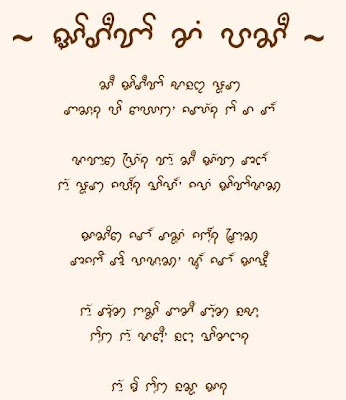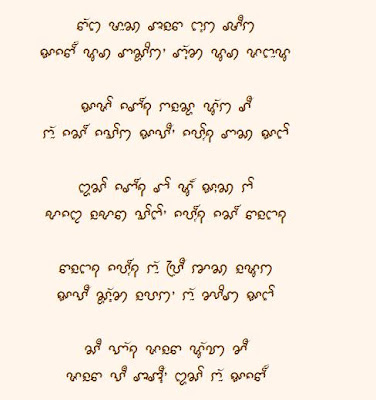





















- ELEMENTS OF THE ARIYA -
Speaker/ Persona
It seemed to be a dialogue between a guy and a girl.
Guy: “Mayut dreh yau ni aey haleng”. Haleng is girl darling.
Setting
(1) Background Setting
:: The girl’s house – “Sang suer mariah siam ndei”
:: The guy’s bedroom – “Tamâ tel duk cei ndih”
:: A path in a bush – “Rimaong daok pagrang di krâh jalan”
:: A tree – “Ala phun hara tattey rambah”
:: A forest (?) – “Ka than kau rimbah mai daok di glai”
(2) Time Setting
:: Night – “Malam ndih sa tuk min wer”
:: Afternoon – “Amâ amaik patey kau di pandiak”
Themes
:: Love and Passion between both guy and girl is the main theme.
:: Sacrifice is another theme. The girl was willing to abandon her family and against the tradition for her beloved guy.
Motif
:: Love
:: Craze
:: Enthusiasm
:: Belief and tradition
Tone & Mood
:: Sad and gloomy.
Structure & Style
:: This ariya is a symbolic poem.
:: Rhyme scheme:
(1) ab, bc, cd, de, ef....
Ni ariya sa-ai ngap (a)
Panâh ba tabiak, piéh ka ra peng,, (b)
Mayut dreh yau ni aey haleng (c)
Kau ngap blaoh padeng, dom ayamân,, (d)
Anit saong ranam klaoh prân (e)
Haké hu damân mbeng saong anguei,, (f)
Kau huec kanda pacei puec suei (g)
Klak kau matuei luai pacalah,, (h)
Kau o klak nai ah (i)
Kau huec calah yua amaik amâ,, (j)
Haley tian kau praong lo ka hâ (k)
Amaik saong amâ kau ndua sa gah (l)
(2) Parallelism (?)
Ni ariya sa-ai ngap,
Panâh ba tabiak piéh ka ra peng,,
Mayut dreh yau ni aey haleng,
Kau ngap blaoh padeng dom ayamân,,
:: Poetic Devices:
(1) Antagonist characteristic showed by the girl’s family.
“Inâ pacalah kau di pacei"
(2) Dialogue
“Cei ley kau biai yau ni baik ah, than drei rambah o bik payau” – She talked to him.
“Adei ley amaik amâ ké thau, kau ciip ndua maluw gep gan ra klao” – He talked to her.
(3) Monologue
“Aey juk gila o dreh yau urang”
(4) Hyperbole
“Raiy rup dahlak yaom ndae candiéng”
(5) Object Imagery – ciéw, kajang, ba-ar, hahuei; Color Imagery – Mâriah.
(6) Anthropomorphism
“Tamia di mblang sa drei pabaiy”
(7) Metaphor
“Huak oh tamâ ndih jang oh wer”
(8) Foreshadow
“Mâyah lac mâtai, ndih sa lubang”
(9) Simile
“Pajaih nai pajaih ciim heng”
(10) Repetition
“Anit saong ranam praong lo, likau dher di Po taom sa anih” ... “Anit saong ranam praong lo, likau dhar di Po drep o salih”
(11) Symbolism
“Sang suer inâgaray kaong dar” – Huge house symbolizes wealth and riches.
(12) Assonance
“Cakaong baong kanai ba nao” …”amaik amâ batuk éw mai tanyi”
(13) Alliteration
“Dahlak daok gandeng blaoh lua tamâ” …”sa-ai sait paga blaoh nao talaih”
(14) Anaphora
“Cuh aem kanai biak ligaih"…“Cuh aem amaik amâ o laow” …”Cuh aem kanai biak ndang”
(15) Responsi
* Dahlak copy mângaok copy min ariya ni..biak dahlak hawing saong hadom abaoh panuec dalam ni wak oh sa jalan wak. Pagep : “ra”, “hâ”, “o” wak saong “balau” ngan oh hu “balau”...”ranem” ngan “dher”...mâda kanain wak hu “paoh thek”, kanain krei wek oh hu. Akhar “Mâk” “Mak” ngan..“rambah” “rimbah”....?





2 comments:
mbek wek ka 'Wak Njep'
Harak1:
k2. Panâh - oh hu takai kâk, kayua dalam inâ akhar Nâk nyu hu 'â' pajae
k2. "Piéh" saong "Pieh": wak halei jang hu, min "Pieh" bian urang wak
k4. Padeng: oh hu Balau di mangaok Pa
k4. Ayamân: jang oh hu balau
k5. Anit saong ranem - oh njep "Séng"
k6. Damân - oh hu tkai kâk; Saong - oh njep "Séng"
k9. Pacalah - oh hu Balau
Harak2:
k5. wak Thal/Athal: oh njep "Than"
Harak3 tel n: >>> Kumei éng aiek nyâ ^^
Ok, ndua karun ka Ikan hu tuk tok maong aiek wek ariya ni. Dahlak birau marat taong agal Cam pandar kibod(keyboard) min kieng chamar(saman) ndei nan jieng ataong chung yae. Pieh ka pak ni, harei hadei hu bél lak edit wek. Min Ikan, panuec “than” nan lo ndei ariya krei jang éw than, oh hu “asal”.. Perhaps “asal” is a modern word…?
Post a Comment